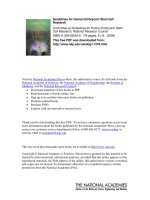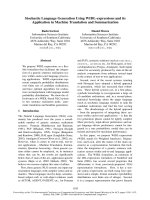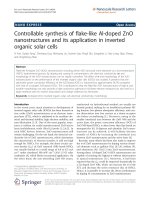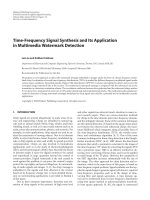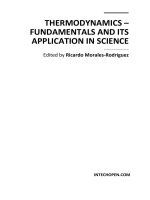n vitro bioassembled human extracellular matrix and its application in human embryonic stem cell cultivation 4
Bạn đang xem bản rút gọn của tài liệu. Xem và tải ngay bản đầy đủ của tài liệu tại đây (9.63 MB, 16 trang )
58
59
60
61
In the initial passage, hESCs cultured onto DxSDOCDOC matrices showed a
decrease in their population doublings, which could be due to the initial
adaptive state of the hESCs. However, with subsequent passages, hESCs
began to proliferate and increase population doublings at a similar rate to the
control hESCs on Matrigel, as evident from the gradients of the two series.
hESCs cultured on DxSDOC matrices also showed a decrease in the
population doublings in the first two passages, but quickly regained population
doublings similar to the control hESCs. By the 11
th
passage, population
doublings of hESCs on DxSDOC matrices dipped slightly compared to the
control hESCs, but again regained the same proliferation rate.
62
Control hESCs that were cultured on Matrigel proliferated at approximately
the same rate for the first 13 passages, before losing the fast proliferation rate
at the 14th passage. From passage 14 to 15, population doublings remained
stagnant, and only began to increase at the 16
th
passage. By this passage,
hESCs on DxSDOC and DxSDOCDOC matrices began to surpass the control
hESCs in terms of population doublings (16.8% versus 13.2%)), and up till the
23
rd
passage, the population doubling rate of control hESCs continued to
remain lower than the hESCs on the two bioassembled matrices, such that the
latter two far exceeded the control hESCs (24.8% versus 19.8%).
From these observations, it was concluded that in long-term passaging, using
collagenase IV and defined culture medium, mTeSR-1, hESCs on either
DxSDOC matrices or DxSDOCDOC matrices were able to proliferate more
than control hESCs on Matrigel. hESCs have long been reported to be able to
proliferate for up to 100 passages, albeit under feeder co-culture systems [3, 4,
7]. hESCs have also been reported to proliferate for up to 20 passages on
Matrigel-coated wells, using enzymatic passaging techniques and MEF-
conditioned medium [4]. According to mTeSR-1’s manufacturers, StemCell
Technologies, hESCs can be cultured on Matrigel in the defined culture
medium for up to 18 passages [23]. When proliferation rate of hESCs begins
to slow down, it is a sign of the aging of the cells. hESCs on feeder-free
culture systems tend to acquire senescence at earlier passages compared to
those on feeder co-culture systems, and senescence is usually accompanied by
morphological changes. Hence, phase contrast images of the hESCs were
taken to observe these morphological differences.
63
3.5.2 Morphology of hESCs
Phase contrast images of hESCs on both bio-assembled matrices and also the
control hESCs were taken at an earlier passage, passage +5, and compared to a
later passage at passage +20 (Figure 5B). At the earlier passage, hESCs on all
three matrices grew in tight, round colonies, with clearly-defined edges, and
each cell showed a high nuclei to cytoplasm ratio. The colony sizes for hESCs
cultured on DxSDOC and DxSDOCDOC matrices appeared smaller compared
to the controls.
At the later passages, the majority of hESCs on all three matrices still grew in
tight colonies, but for hESCs that were cultured on either Matrigel or
DxSDOC, there were significant fractions that grew on the periphery of
colonies, with flattened morphology that did not have high nuclei to cytoplasm
ratios, resembling spontaneously differentiated cells. Although hESCs on
DxSDOCDOC did have some spontaneously differentiated cells in the
population, these cells were not common. Colonies of hESCs on
DxSDOCDOC were larger in the later passage compared to the earlier
passage, but still remained round and tight with defined colony margins.
As reported earlier, the population doublings of the hESCs on bioassembled
matrices DxSDOC and DxSDOCDOC exceeded the control hESCs, and yet,
despite the extensive passaging, the hESCs on DxSDOCDOC matrices still
retained morphology more similar to earlier passage hESCs.
64
3.5.3 Pluripotency markers levels by flow cytometry
A panel of five pluripotency markers, Oct-4, SSEA-3, SSEA-4, TRA-1-60 and
TRA-1-81 was used to characterize the hESCs after 5 passages on either
Matrigel, DxSDOC or DxSDOCDOC matrices. For each hESC sample,
triplicates of 10,000 labeled cells were used for each marker. An average of
the percentage of positively-labeled cells of each triplicates was plotted,
together with the standard deviation (Figure 5C).
Comparing the population percentage of hESCs positive for the Oct-4 marker,
62.4% of hESCs on Matrigel expressed Oct-4, while 62.6% of hESCs on
DxSDOC matrix expressed the marker and only 42.2% of hESCs on
DxSDOCDOC matrix expressed the marker. Oct-4 is a POU transcription
factor responsible for activating several genes important for maintaining the
pluripotency of hESCs. Oct-4 has been found to be highly expressed in
pluripotent hESCs [9]. The pattern of Oct-4 expression in human embryos is
similar to that of mouse embryos [10], where Oct-4 is expressed in totipotent
embryonic cells, then becomes restricted to the ECM of the blastocysts. Oct-4
becomes down-regulated in trophoectoderm and primitive endoderm of the
mouse embryo. Later, it is maintained in the embryonic ectoderm at the
cylinder stage, and down-regulated at gastrulation in an anterior-posterior
pattern. Germ cells continue to maintain the expression of Oct-4 until the
initiation of sexual differentiation [10]. The under-expression of Oct-4 in ES
cells leads to their differentiation into trophoectoderm lineages [10], indicating
the crucial role that Oct-4 plays in maintaining the pluripotent state of ES
cells. As Oct-4 is a transcription factor, naturally it is found within the nuclei
65
of hESCs, and so, in order to obtain successful Oct-4 immunostaining, the
cells have to be first permeabilized using 0.2% Triton-X 100 - this extra
processing step results in markedly increased sample loss, which possibly
accounts for the low population percentage seen in the flow cytometry
readings.
On the other hand, a much higher percentage for the surface markers SSEA-3
and SSEA-4 was seen. 86.9% of hESCs on Matrigel expressed SSEA-3, with
88.9% and 88.7% for hESCs on DxSDOC and DxSDOCDOC respectively.
Similarly, 85.7% of hESCs on Matrigel expressed SSEA-4, with 84.2% and
88.1% for DxSDOC and DxSDOCDOC hESCs respectively.
Only 34.6% of hESCs cultured on Matrigel, 36.8% of hESCs cultured on
DxSDOC and 37.2% of hESCs cultured on DxSDOCDOC were positive for
TRA-1-60. Conversely, 77.7% and 75.1% of hESCs cultured on Matrigel and
DxSDOC respectively were positive for TRA-1-81. 50.6% of hESCs cultured
on DxSDOCDOC were positive for TRA-1-81.
Overall, other than for the markers Oct-4 and TRA-1-81, hESCs on DxSDOC
and DxSDOCDOC scored comparatively similar to hESCs on Matrigel in the
expression of pluripotency markers.
hESCs that were cultured on the three various matrices were harvested into
single cell suspensions at passage +20 and immunolabeled with the same
antibodies as those used in the earlier passage samples. Across the panel of the
66
five pluripotency markers, flow cytometry of the hESCs under the three
conditions showed comparable expression, except for Oct-4 (Figure 5D).
Oct-4 positive cells were found to be present in 47.2% of hESCs cultured on
Matrigel, compared to only 23.4% of hESCs on DxSDOC and 31.5% of
hESCs on DxSDOCDOC.
However, for all the other four the surface markers, the three populations had
comparable expression. 77.5% of hESCs on Matrigel were positive for SSEA-
3, with 72.2% for hESCs on DxSDOC and 70.6% for hESCs on
DxSDOCDOC. 78.9% of hESCs on Matrigel were positive for SSEA-4, and
85% for hESCs on DxSDOC and 75.1% of hESCs on DxSDOCDOC. TRA-1-
60 markers expression was present in 52.4% of hESCs on Matrigel, 40.9% for
hESCs on DxSDOC and 49.4% of hESCs on DxSDOCDOC. 36.9% of hESCs
on Matrigel showed positive staining for TRA-1-81, 31.1% in hESCs on
DxSDOC and 41.7% in hESCs on DxSDOCDOC. Taking into account that
the surface marker levels were similar in the three population samples, hESCs
on DxSDOC and DxSDOCDOC did not differ much from hESCs on Matrigel
in terms of pluripotency marker expression. However, if the population
doubling results mentioned in section 3.5.1 were considered, there was a
marked increase in the number of population doublings in hESCs cultured on
DxSDOC and DxSDOCDOC matrices, in comparison to the control hESCs,
and yet, there was comparable expression of pluripotency markers even at a
late passage of 20, this observation showed that the bio-assembled matrices
67
DxSDOC and DxSDOCDOC were able to increase the population doublings
and yet maintain the pluripotency of hESCs, in comparison to the controls.
3.5.4 Pluripotency markers levels by immunofluorescence
To confirm the morphological observations in section 3.5.2 and to confirm the
flow cytometry results in section 3.5.3, adherent colonies of hESCs cultured
on the three matrices were labeled using antibodies against the pluripotency
markers of hESCs, Oct-4, SSEA-4, SSEA-3, TRA-1-81 and TRA-1-60.
As observed earlier, hESCs cultured on Matrigel, DxSDOC and
DxSDOCDOC for 5 passages grew in colonies that exhibited pluripotent
morphological characteristics, and these colonies were composed of cells that
were positive for all five pluripotency markers (Figure 5E-G).
At later passages (passage +20) there were fractions of hESCs on Matrigel and
DxSDOC that were not positive for one or more of the markers (arrows)
(Figure 5H-J). There were also fractions of hESCs on DxSDOCDOC that
were not positive for the pluripotency marker TRA-1-60 (Figure 5I), but as
mentioned earlier, these cells were not common.
Hence, the immunofluorescence studies of the adherent cultures corroborate
with the earlier observations.
68
3.5.5 In vivo induced differentiation
hESCs that were cultured for 18 passages on DxSDOC, DxSDOCDOC and
control hESCs on Matrigel were harvested by collagenase IV and implanted
into the right hind limb of a SCID mouse. The left hind limb was untouched
and designated as the control limb. The SCID mice were incubated for 9
weeks, after which teratomas from hESCs on DxSDOC and DxSDOCDOC
were easily palpable.
The teratomas formed from hESCs cultured on DxSDOC and DxSDOCDOC
matrices were harvested for formaldehyde fixation, microsectioning and H&E
staining. Differentiated structures were observed in both teratomas, with
identifiable neural rosettes (NR), mucous secreting epithelium (MSE),
cartilogenous structures (C) and osseous structures (B) (Figure 5K). These
observations indicate that after 18 passages on DxSDOC or DxSDOCDOC,
these hESCs were still able to differentiate into complex differentiated
structures, demonstrating their retention of differentiation capability after
prolonged culture.
hESCs that were cultured on Matrigel did not form any obvious teratomas, and
despite an extension of incubation time by another two weeks, no teratomas
were palpable. A repeat implantation was made using frozen hESCs that were
cultured on Matrigel. These hESCs were allowed to recover from thawing for
2 passages before the implantation was made, but remained unable to form
teratomas. It is likely that the control hESCs had lost their differentiation
capacity by the 18
th
passage. Teratoma assays were previously proven to be
69
positive for H9 hESCs cultured in this particular way for only 6 passages, as
stated by mTeSR-1’s manufacturers, and have not yet been proven positive for
more extensive periods. However, hESCs cultured on Matrigel using TeSR-1,
the original animal-free culture medium that led to the development of
mTeSR-1, were able to form teratomas after 20 passages [23]. Thus it is
possible that the use of animal components such as BSA to replace human
serum has led to the failure of this culture medium to maintain differentiation
capacity of hESCs when cultured on Matrigel.
In contrast, hESCs cultured on DxSDOC and DxSDOCDOC continued to
retain their teratoma formation capacity, indicating that the bio-assembled
human matrices are providing hESCs with the necessary environmental cues,
which are lacking in the mTeSR-1 and Matrigel culture systems.
3.5.6 Karyotype
hESC cultured on the three matrices were tested karyotypically after 18
passages. Of the three samples, hESCs cultured on DxSDOCDOC matrix
showed normal metaphases on all 20 metaphases tested (Figure 5L). 18 of the
20 metaphases of hESCs cultured on DxSDOC matrix showed normal
karyotypes, but 2 metaphases showed non-clonal abnormalities. 19 out of 20
metaphases of hESCs cultured on Matrigel for 18 passages showed normal
karyotype, but 1 metaphase showed trisomy in chromosome 8. Because only 1
or 2 out of 20 metaphase showed the chromosomal abnormality, the cells were
considered as normal, and the abnormality may have been due to technical
artifacts or random mitotic errors [71].
70
3.5.7 DNA Methylation
hESCs cultured on Matrigel, DxSDOC and DxSDOCDOC were analyzed
using the Illumina Methylation Assay – Infinium II platform to profile DNA
methylation states of the genes on a genome-wide basis. The assay measured
the methylation levels of 27,578 CpG dinucleotides of 14,495 genes. DNA
methylation plays an important part in epigenetic regulation. In DNA
methylation, methyl groups are added to DNA, typically at CpG sites, and
highly methylated areas of the genome tend to be less transcriptionally active.
It has been shown that changes to the methylation pattern and levels can
contribute to cancer and other various developmental diseases [72].
The methylation states of hESCs on Matrigel versus the respective
methylation states of the same CpG of hESCs on DxSDOC was plotted
(Figure 5M). The same was repeated for hESCs on Matrigel versus hESCs on
DxSDOCDOC and for hESCs on DxSDOC versus hESCs on DxSDOCDOC.
The coefficient of determinant R
2
, which gives an indication of the goodness
of fit between the two samples, was calculated (Figure 5M). An R
2
value of
1.0 indicates a perfect fit, while an R
2
value of more than 0.95 indicates
similarity. In all three comparisons, the R
2
values were found to be more than
0.95, therefore hESCs under all the three matrix conditions were similar to
each other, with only slight differences. Interestingly, the R
2
value for hESCs
on Matrigel versus hESCs on DxSDOC (0.9707) and the R
2
value for hESC
on DxSDOC versus hESC on DxSDOCDOC (0.9682) was lower than the R
2
value of hESCs on Matrigel versus hESCs on DxSDOCDOC (0.9808),
71
indicating that hESCs on DxSDOC was the more dissimilar to the hESCs on
the other two matrix conditions, and hESCs on DxSDOCDOC was more like
hESCs on Matrigel.
This epigenetic analysis shows that on the epigenetic level, there are no major
differences between hESCs on Matrigel, DxSDOC and DxSDOCDOC. This
observation is in contrast to the differences in cellular behaviour, such as
morphology, expression of pluripotency markers, and retention of
differentiation capacity. This contradiction could be due to the fact that the
assay does not completely encompass all the 17,052 genes identified to date.
Moreover, with only about 2 CpGs to represent each gene, and with several
CpGs found in each gene, the assay does not cover all the CpGs in the entire
genome. Hence, the epigenetic analysis at this point is still limited and not
complete, and as a result, it might not have captured the true epigenetic
differences between the samples.
3.5.8 DxSDOCDOC matrices were able to maintain pluripotent hESCs
Based on population doubling observations, morphology, pluripotency marker
expression, in vivo differentiation studies and karyotype results, it was
concluded that hESCs cultured on DxSDOCDOC showed superior population
doubling rates, while maintaining pluripotent-like morphology compared to
control hESCs on Matrigel. Pluripotency marker expressions were comparable
to the control hESCs by flow cytometry and by adherent immunofluorescence
studies, and the hESCs on DxSDOCDOC had fewer areas of differentiation
compared to the control. In vivo differentiation studies showed that hESCs
72
cultured on DxSDOCDOC matrices retained their differentiation capacity and
yet maintained their karyotypic integrity despite prolonged culture periods.
3.6 Matrices that maintain hESC pluripotency (Repeat)
3.6.1 Repeat propagation trial
A repeat of the above-mentioned propagation trial was conducted, with hESCs
cultured on DxSDOCDOC matrices, and control hESCs cultured on Matrigel,
for up to 13 passages. Collagenase IV was used for enzymatic passaging, and
defined culture medium, mTeSR-1 was used to maintain the hESCs. The
purpose of this trial was to confirm the earlier observations that
DxSDOCDOC matrices were able to maintain hESCs in a pluripotent state
compared to Matrigel with increased population doublings.
3.6.2 Population doublings
Similar to the earlier propagation trial, representative wells were sacrificed for
cell counting at each passage, to obtain the population doublings, which was
plotted (Figure 6A). In the first eight passages, population doublings were
similar in both hESCs cultured on Matrigel and DxSDOCDOC matrices. The
dip in population doublings in the 2nd passage could be due to the adaptation
of the hESCs to the matrices. From the 9th passage onwards, the population
doubling rate of hESCs cultured on DxSDOCDOC began to surpass the
control hESCs. By the 13
th
passage, hESCs cultured on DxSDOCDOC
matrices showed a 42.5% increase in population doublings in comparison to
the control. Hence, it was confirmed that DxSDOCDOC matrix enables the
higher proliferation rate of hESCs compared to control hESCs on Matrigel.
73

